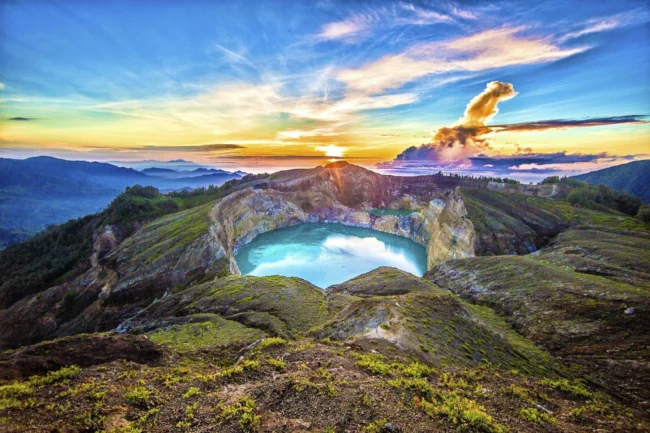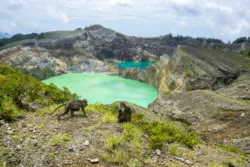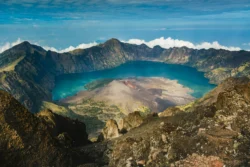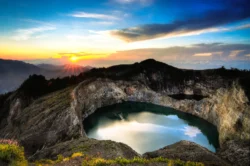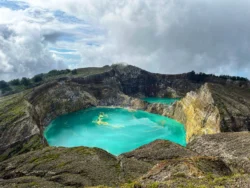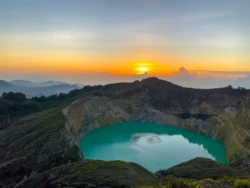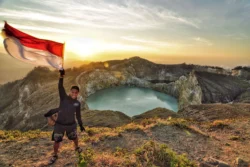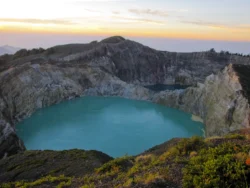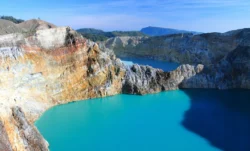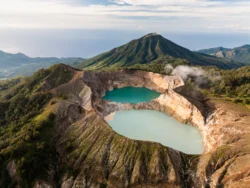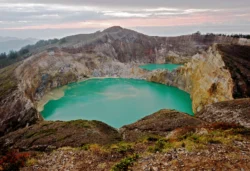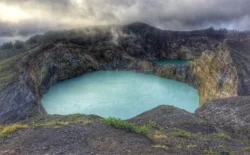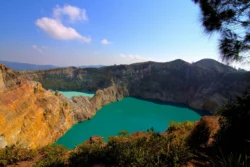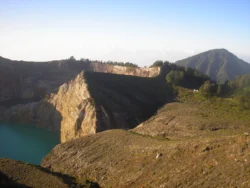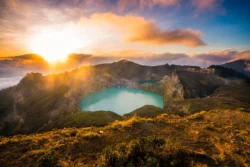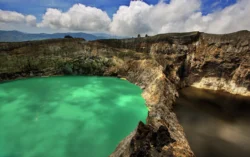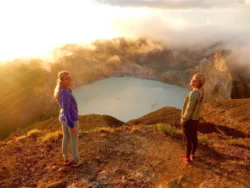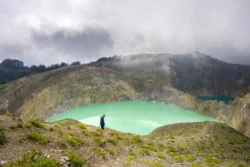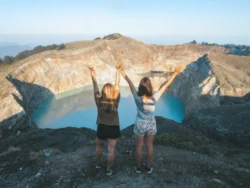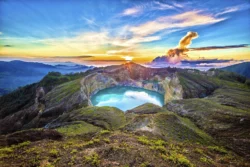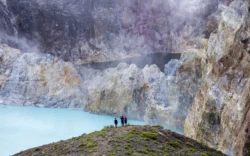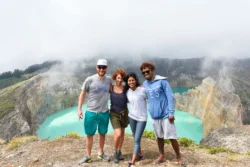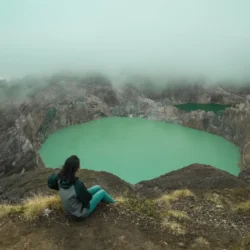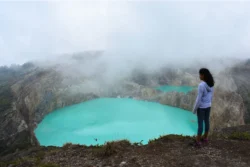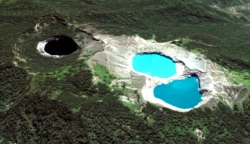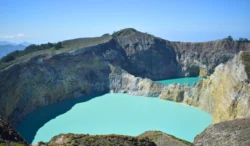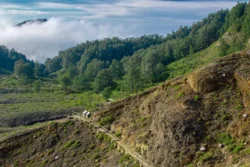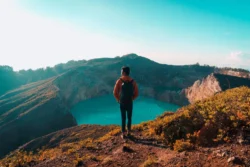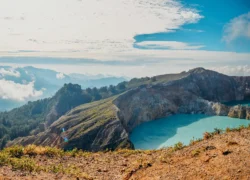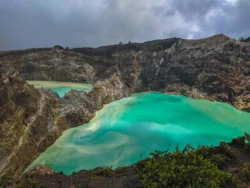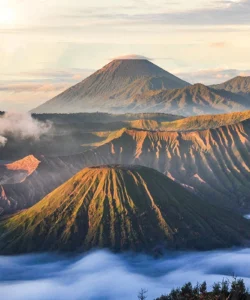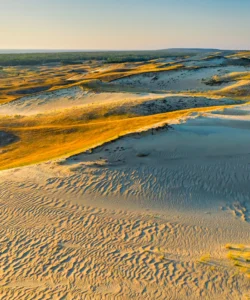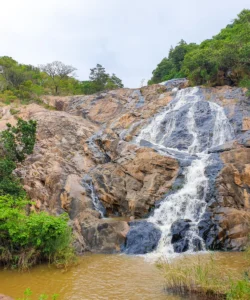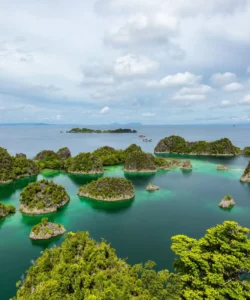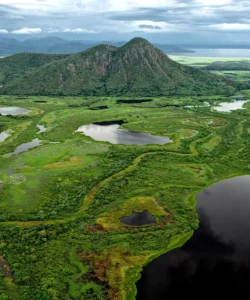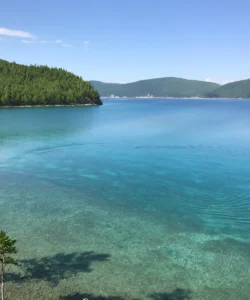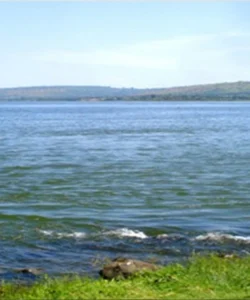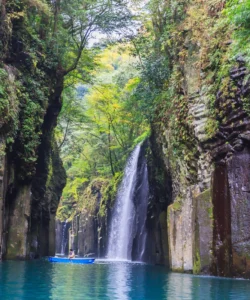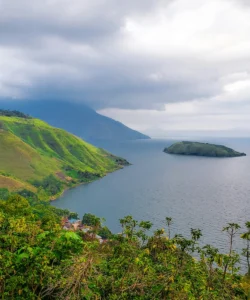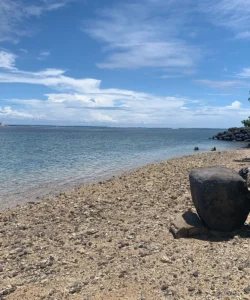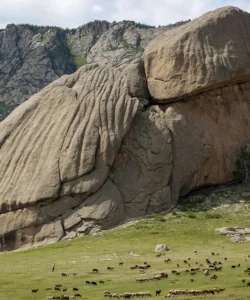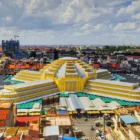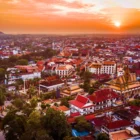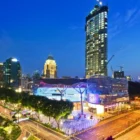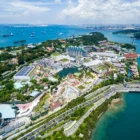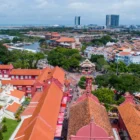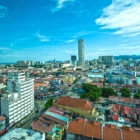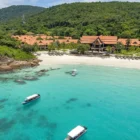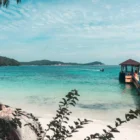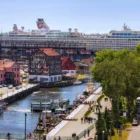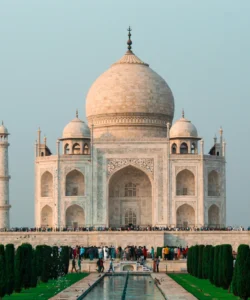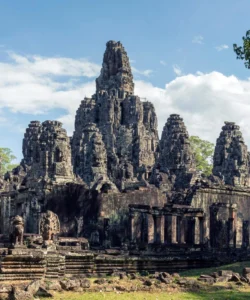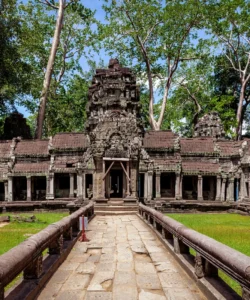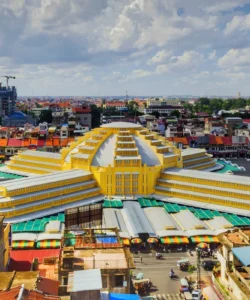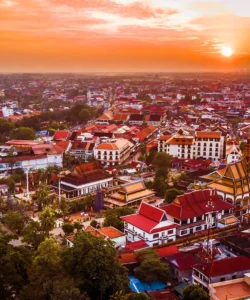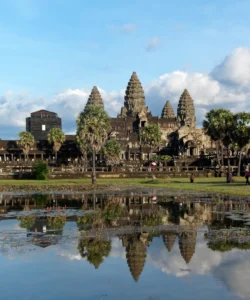Kelimutu National Park, located on the island of Flores in East Nusa Tenggara, Indonesia, is a captivating natural wonder renowned for its extraordinary tri-colored crater lakes. It’s a place where geology, mystery, and local folklore intertwine, creating a truly unique and mystical experience.
Name: Kelimutu National Park (Indonesian: Taman Nasional Kelimutu)
Address: The park is centered around Mount Kelimutu, near the small town of Moni, in the Ende Regency on Flores Island, East Nusa Tenggara, Indonesia.
How to Get There:
Reaching Kelimutu National Park typically involves flying to Flores and then taking land transport to Moni, the closest village to the park entrance.
- By Air to Flores:
- The most common gateway airports on Flores Island are H. Hasan Aroeboesman Airport (ENE) in Ende or Frans Seda Airport (MOF) in Maumere.
- There are direct flights to Ende or Maumere from major Indonesian cities like Denpasar (Bali – DPS) or Jakarta (CGK). Flight from Bali to Ende takes about 1 hour 40 minutes.
- If you’re already in Labuan Bajo (Komodo National Park), you can take a short flight (around 50 minutes) to Ende.
- From Ende or Maumere to Moni:
- From Ende to Moni: Moni is approximately 50 km (31 miles) from Ende. You can hire a private car/taxi (approx. 1.5 – 2 hours), take a shared van, or a public bus/bemo (local minibus). The road is winding but generally in good condition.
- From Maumere to Moni: Moni is further from Maumere (approx. 3-4 hours drive), but similar transport options are available.
- From Moni to Kelimutu National Park Entrance:
- Scooter Rental: Many visitors rent a scooter in Moni (approx. IDR 125,000/day) and drive themselves up the mountain. The road is well-paved but steep in parts (about 30 minutes drive).
- Ojek (Motorcycle Taxi): You can hire an ojek (around IDR 100,000 for a round trip) to take you up to the parking area.
- Private Driver: Your guesthouse in Moni can usually arrange a private driver (approx. IDR 200,000-300,000 for a round trip).
- Trekking: For the adventurous, it’s possible to trek from Moni to the park entrance (around 2-3 hours), passing through scenic rice paddies and villages.
- From Parking Area to Lakes: Once at the parking area, it’s a relatively easy 15-30 minute hike up a well-marked path and stairs to the main viewpoint (“Inspiration Point”), from where all three lakes are visible.
- Park Entrance Fee: There is a national park entrance fee (currently around IDR 150,000 for foreigners on weekdays, IDR 225,000 on Sundays).
Best Time to Visit:
The best time to visit Kelimutu National Park is during the dry season, from April to November. During these months, the weather is generally clear, offering the best chances for unobstructed views of the lakes, especially at sunrise. Clouds and fog can often roll in later in the morning.
Landscape and Architecture:
Kelimutu’s landscape is a dramatic volcanic creation, distinguished by its unique and mystical crater lakes. Its “architecture” is almost entirely natural, sculpted by geothermal forces.
- Mount Kelimutu Volcano: The park is centered on Mount Kelimutu, an active stratovolcano (1,639 meters / 5,377 feet high). The summit is somewhat elongated, featuring several older cones in the surrounding area.
- The Tri-Colored Crater Lakes: The most famous feature are the three striking summit crater lakes, each with a distinct and often independently changing color:
- Tiwu Ata Bupu (Lake of Old People): The westernmost lake, usually dark blue or green, traditionally believed to be the resting place for the souls of the elderly.
- Tiwu Nuwa Muri Ko’o Fai (Lake of Young Men and Maidens): The middle lake, often turquoise, light blue, or white-green, believed to be for the souls of young people who died prematurely.
- Tiwu Ata Polo (Bewitched or Enchanted Lake): The easternmost lake, often changing dramatically to red, dark green, brown, or even black, believed to be for the souls of sorcerers or wicked people.
- Volcanic Activity and Mineral Reactions: The scientific reason for the color changes is complex but generally attributed to chemical reactions within the lakes’ water, influenced by the differing mineral compositions, the oxidation-reduction status of the fluid, and the continuous release of volcanic gases (like sulfur dioxide and hydrogen sulfide) from fumaroles at the bottom of the craters. The lakes have different pH levels, contributing to their distinct colors.
- Rugged Volcanic Terrain: The surrounding landscape is characterized by rugged volcanic terrain, with exposed rocks, loose scree, and sparse vegetation at the summit.
- Lush Forests and Biodiversity: Despite the barren summit, the lower slopes of the national park are covered in lush montane forests and sub-alpine vegetation. The park is home to unique Wallacean biodiversity, including endemic plant species (like Begonia kelimutuensis) and rare animals (Javan rusa deer, wild boars, and endemic birds like the Flores monarch and Kelimutu white-eye). An arboretum near the entrance showcases the park’s flora.
- Simple Viewing Infrastructure: At the summit, there’s a relatively simple viewing platform called “Inspiration Point” and a staircase leading up to it, providing safe vantage points to observe all three lakes. Railings are in place for safety, but scrambling off-path is discouraged due to unstable ground.
What Makes It Famous:
- Tri-Colored Changing Lakes: This is the park’s unequivocal claim to fame. The phenomenon of three crater lakes on the same volcano having distinct and frequently changing colors is incredibly rare and visually stunning. This unpredictable nature adds to its mystique.
- Spiritual and Mystical Significance: Deeply sacred to the local Lio people, the lakes are believed to be the final resting place of departed souls, with each lake corresponding to a different type of spirit. This rich local folklore adds a profound mystical aura to the site.
- Iconic Sunrise Experience: Witnessing the sun rise over the multi-colored lakes, as the mist clears to reveal their vibrant hues, is a world-renowned and highly sought-after experience for photographers and travelers.
- Geological Marvel: From a scientific perspective, Kelimutu is a fascinating natural laboratory, offering insights into volcanic geochemistry and the complex interactions between minerals, gases, and water acidity that drive the color changes.
- Flores Island Highlight: It is one of the absolute must-visit highlights on the island of Flores, often combined with trips to Komodo National Park and other cultural sites.
- Wallacean Biodiversity: Despite its volcanic landscape, the park protects unique flora and fauna endemic to the Wallacea biogeographical region.
Differences from Some Other Wonders:
- Dynamic, Color-Changing Lakes: While other volcanoes might have crater lakes (e.g., Kawah Ijen’s acidic turquoise lake), Kelimutu’s uniqueness lies in having three separate lakes on the same volcano that change color independently and unpredictably. This dynamic, living landscape sets it apart from static natural formations.
- Spiritual “Afterlife” Connection: The deep-rooted local belief that the lakes are the direct resting places for specific types of departed souls, guiding the color changes, imbues Kelimutu with a specific spiritual and mythological narrative that is more profound and directly tied to its features than many other natural wonders.
- Accessible Volcanic Crater Lakes: While other volcanoes can be challenging to climb (e.g., Mount Bromo’s direct crater climb, or the long trek up Mount Kinabalu), the hike to the Kelimutu lakes from the parking area is relatively short and easy, making this unique volcanic phenomenon accessible to a wider range of visitors.
- Less about “Big Game” Wildlife: Unlike Komodo National Park (Komodo dragons) or African safari parks, Kelimutu National Park’s fame is primarily about its geological and cultural significance, with wildlife (endemic birds, small mammals) being a secondary, though important, aspect.
- Mountain and Lakes as Sole Focus: Unlike the sprawling caldera of Mount Bromo or the vast island chains of Raja Ampat, Kelimutu’s “wonder” is highly concentrated around the three distinct lakes at the summit of a single volcano.
Kelimutu National Park Photos:
